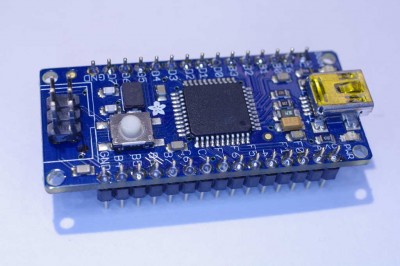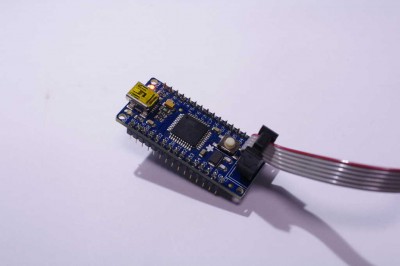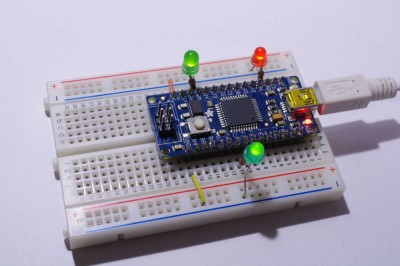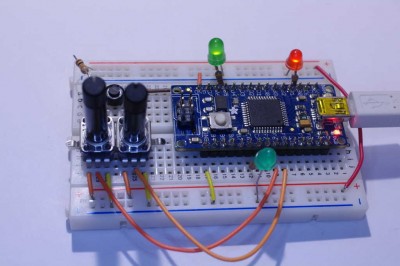Arafruit 32U4 breakout board+でArduino Leonardoのファームウエアを試すTrying Arduino Leonardo with Arafruit 32U4 breakout board+
1.はじめに
先週NYCで開催されたOpen Hardware Summitで新しいArduinoが発表されました。
その中でローエンドと位置づけられるArduino Leonardは、USBを内蔵したマイクロプロセッサであるATMega32U4を採用しています。まだ回路は公開させていませんが、USB周りは利用するピンが決まっていますので誰が設計しても変わりません。あとはピンの配置だけで、素直な作りが想定されます。
Arduino Leonardoの発売はまだ10月ですが、すでに公開されているArduino 1.0 RC1には、そのソフトウエアが含まれています。そこで、一足先にAdafruitの開発しているArafruit 32U4 breakout board+を使って、Leonardoの使い勝手を試してみました。
1.Introduction
Last week a set of new Arduino is introduced at Open Hardware Summit.
I’m interested in Arduino Leonardo, which is the low end board with ATMega32U4 micro processor with USB. Although the schematic of Leonardo is not published at this point, the design of Leonrdo must be straight forward, except the assignment of digital and analog pins.
The firmware and core codes for Arduino Leonardo are already in Arduino 1.0 RC1, which was published in September 17.
I decide to try Leonardo with Arafruit 32U4 breakout board+, as it also uses ATmega32U4.

2.Requrements
- Software : Arduino 1.0 RC1, you can download here
- Hardware : Arafruit 32U4 breakout board+ , you might use any 32U4 board
- Tools : ISP programmer such as ,USBTinyISP, and AVRISP by ATMEL
- LED, Pods and registers
3. Burning the boot loader
You need to burn boot loader from Arduino 1.0 RC1. I use ISP programmer with the following steps.
- solder an ISP connector on 32U4 Breakout board. Connect ISP programmer with the connector.
- On Arduino 1.0 RC1, choose ‘Tools’ ->’ Board’ -> ‘Arduino Leonardo’
- Choose ‘Tools’ -> ‘Programmer’ -> ‘USBTinyISP’
- Choose ‘Tools’ ->’BurnBootloader’, then wait a couple of minutes
4. Try Blink example
- After burning firmware, I connected the breakout board to Mac with USB port. From Mac, the board is recognized as ‘Arduino Leonardo’
- Connect two 10K Ohm pods to A1(PF6) and A2(PF5).
- Connect a tact switch to D6(PD7) and GND
- Connect a LED and register to D5(PC6)
I open an example sketch named blink, then download the program to Leonardo.
5.Human Interface Device (Mouse)
The most interesting feature of Arduino Leonardo is the emulation of Mouse and Keyboard. One can make USB-HID class device with Leonardo.
I tried one of example sketch named JoystickMouseControl for the next step.
The following hardware setting is used for my trial.
The following pins are assigned on Arduino Leonardo, according to the file (hardware/arduino/variants/leonardo/pins_arduino.h)
// ATMEL ATMEGA32U4 / ARDUINO LEONARDO // // D0 PD2 RXD1/INT2 // D1 PD3 TXD1/INT3 // D2 PD1 SDA SDA/INT1 // D3# PD0 PWM8/SCL OC0B/SCL/INT0 // D4 A6 PD4 ADC8 // D5# PC6 ??? OC3A/#OC4A // D6# A7 PD7 FastPWM #OC4D/ADC10 // D7 PE6 INT6/AIN0 // // D8 PB4 ADC11/PCINT4 // D9# A8 PB5 PWM16 OC1A/#OC4B/ADC13/PCINT5 // D10# A9 PB6 PWM16 OC1B/0c4B/ADC12/PCINT6 // D11# PB7 PWM8/16 0C0A/OC1C/#RTS/PCINT7 // D12 A10 PD6 T1/#OC4D/ADC9 // D13# PC7 PWM10 CLK0/OC4A // // A0 PF7 ADC7 // A1 PF6 ADC6 // A2 PF5 ADC5 // A3 PF4 ADC4 // A4 PF1 ADC1 // A5 PF0 ADC0 // // New pins D14..D17 to map SPI port to digitial pins // // D14 PB0 RXLED,SS/PCINT0 // D15 PB1 SCK,PCINT1 // D16 PB2 MOSI,PCINT2 // D17 PB3 MISO,PCINT3 // // TXLED PD5 // RXLED PB0 // HWB PE2 HWB
EOF



